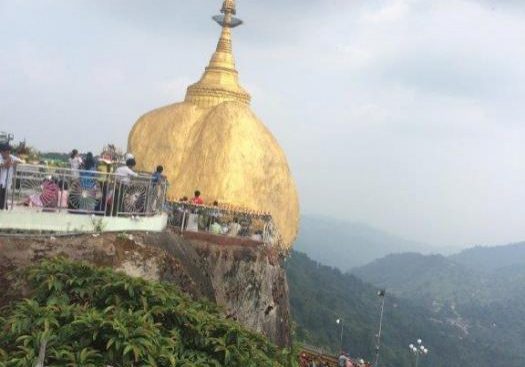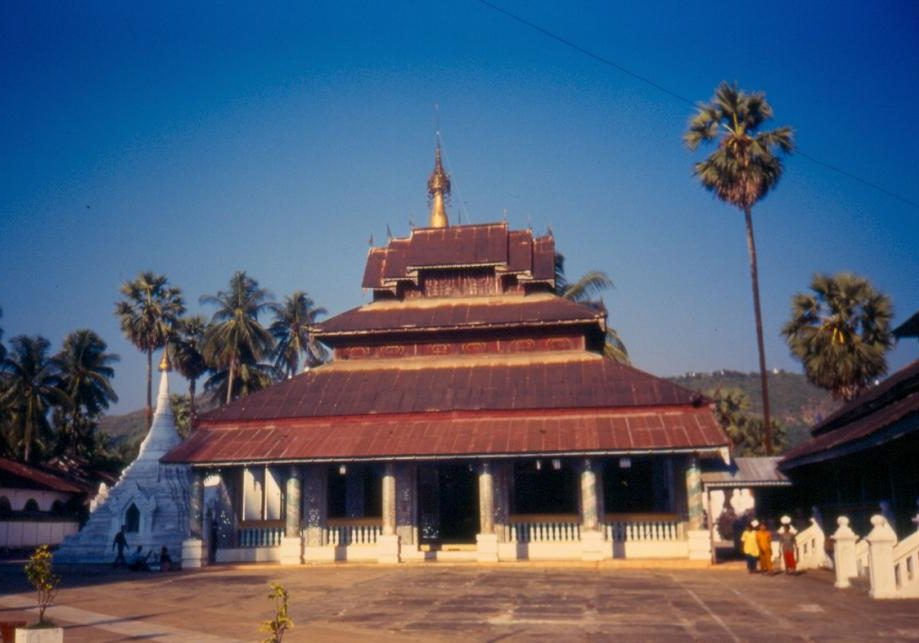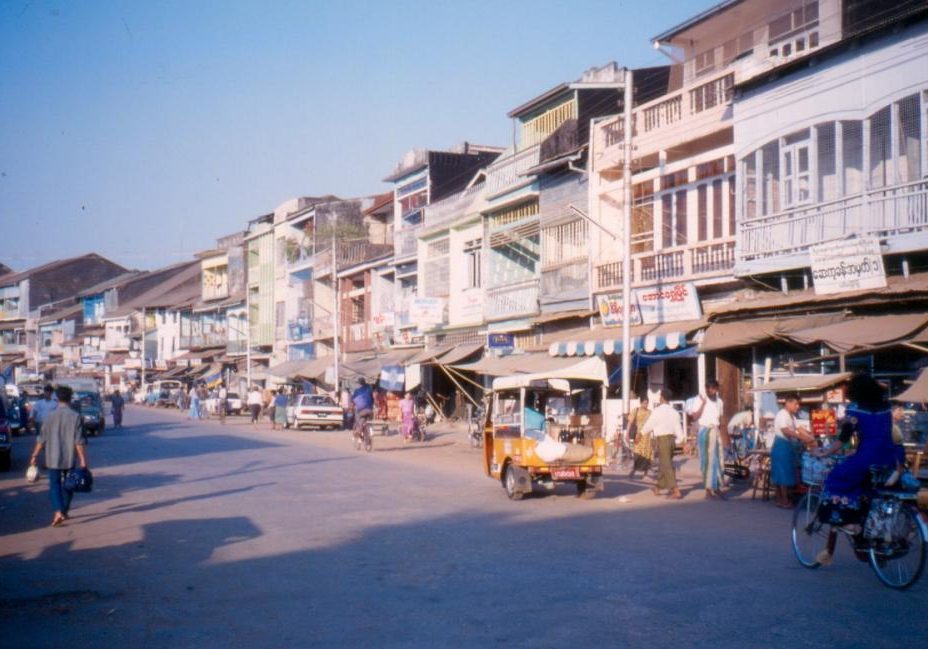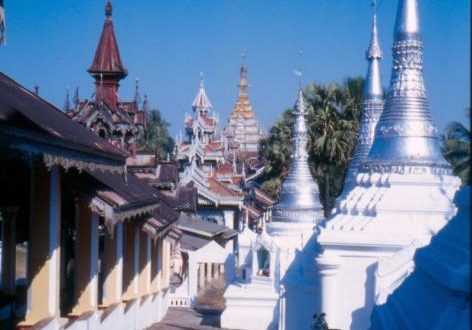Mon State stands along the upper part of the Tanintharyi coastal strip. The total area is 4,747 square miles. There are islands, hills, equatorial forests, crop land and plantations. Mawlamyine, the third largest city in Myanmar, is the capital of Mon State. The famous Kyaikhtiyo Pagoda is located north of Kyaikhto. Thaton is the capital of ancient Mon Kingdom, much earlier than Bagan. There are many beautiful sea resorts such as Kyaikkami and Setse. There is a War Memorial in Thanbyuzayat, connected with the Bridge on the River Kwai.
How to get there
Mawlamyine is accessible by train or car from Yangon. As regards road and railways, the railroad starts from Yangon. It goes on from Mawlamyine to Yay while the motor road goes on beyond the boundary of Mon State right down to Myeik. Heading towards the eastern border with Thailand, there are two routes. The first is the Mawlamyine-Kawkareik-Myawady-Maesot route and the second the Three Pagodas route starting from Thanbyuzayat.
Places of interest
KYAIKHTIYO
The famous legendary Pagoda on the Golden Rock about 160 Km from Yangon and 11 km of hiking from the base camp at Kyaikhto. This pagoda is situated on a rocky mountain 3615 ft above sea level. The Kyaikhtiyo pagoda is one of the most ancient and celebrated of all pagodas in Myanmar. It is situated in the vicinity of Kyaikhto township, Thaton district. The pagoda is said to have been built during the life-time of the Buddha over 2400 years ago.
Before, it was a rare place which was very hard to reach. Nowadays, there are many more convenient transportations and Kyaikhtiyo Pagoda can be accessible easily. There are also convenient accommodations for visitors.
THATON
In the early centuries of the Christian era the Mons were settled in the region between the Sittaung and Salween (Thanlwin) rivers which was known as the Mon kingdom of Ramanyadesa. Thaton, the seat of this kingdom was also known as Suvannabhumi or the Golden Land, which also applies to the whole region of continental south-east Asia around the Bay of Bengal. Doubtless Thaton was flourishing port in ancient and there was constant intercourse between Southern India and the region around Thaton and Pegu (Bago). The old city of Thaton appears to have built on a quadrangular plan like the more modern cities of Amarapura and Mandalay. There are two ramparts in a rectangular shape and the moat lies between the two walls, which are faced with laterite stones. As the present town is developed within the old city the remains of the inner city are no more visible. The chief pagodas are situated between the palace site and the south wall.
SHWEZAYAN PAGODA
The Shwezayan pagoda is said to have been built in the 5th century B.C. It has been built over and has now assumed a modern shape with a circular base and a bell-shaped superstructure. Within the precincts of the Shwezayan pagoda were found seven inscribed stones, five in early Mon of 11th century, one medieval and the seventh illegible. Among the stone sculptures collected in the same building is a figure of standing Buddha depicted in relief on a sandstone slab.
KYAIKHTEE SAUNG PAGODA (AN ANCIENT LATERITE STONE PAGODA)
Is one of the earliest hair relic pagodas in Mon State. Kyaikhtee Saung Pagoda is located on the Laterite Stone hillock. The hillock itself is formed by laying the laterite stones on top of one another forming a big square gradually grind up keeping the form but reducing the size of square intact until it reaches the top platform. At 1971 the monk U Pyinnyadipa (Now, he is the abbot of the monastery and famous as Kyaikhtee Saung Sayadaw) has arrived back his native village Zoke Thoke. He himself found the old pagoda under the huge bushes. He organized his disciples and villagers to clear the bushes. Then he rebuilt and renovated the old pagoda and old laterite hillock. Now, the Kyaikhtee Saung Golden Pagoda has appeared surrounded by the new buildings for the religious purposes.
MAWLAMYINE
Mawlamyine (or Moulmein) is the capital of the Mon State. It is also the third largest city in the country, after Yangon and Mandalay. It has a population of about 240,000. Mawlamyine is an ancient Mon town. The name according to the legend comes from Mot-Mua-Lum, meaning "one eye destroyed". In this legend an ancient king had three eyes, the third eye in the centre of the fore-head having the power of seeing what was going on in surrounding kingdoms. The King of a neighbouring country gave his daughter in marriage to the three-eyed king, and this queen was eventually able to destroy the all-seeing third eye.
The atmosphere of post colonial decay is still palpable here. It’s also an attractive and tropical town with a ride of stupa-capped hills on one side and the sea on the other side. Mawlamyine was the capital of British Burmese from 1827 to 1852, during which time it was a major teak port.
MON CULTURAL MUSEUM
Is a two storey building dedicated to the Mon history of the region. Exhibits are displayed downstairs while reading rooms are upstairs. The modest collection of the museum includes scales with Mon inscriptions, hundred year old sculptures of wood, ceramics, thanaka grinding stones, silver betel boxes, an English language letter dated 22 December 1945 from Bogyoke Aung San to Mo Chit Hlaing, a famous Mon leader laquerware and folding manuscripts. In front of the museum you can see a British cannon dated 1826 and a huge Myanmar gong. Most labels are in Myanmar on although some are in English.
KYAIK-THAN-LAN PAGODA
Three famous pagodas adorn the Mawlamyine Ridge. The Kyaik-thanlan pagoda was erected in 875 A.D. during the reign of King Mutpi Raja. A hair relic of the Buddha, Tripitaka manuscripts and gold images of the Buddha were enshrined in the pagoda. Successive kings raised the pagoda higher, from 56 feet to the present 150 feet. The present base of the pagoda is 450 feet in circumference. There are 34 small pagodas called Zediyan surrounding the pagoda. A lift has now been installed for easy access. Kyaik in Mon language means a Cedi or Stupa The pagoda was repaired by King Anawrahta, founder of the Bagan Dynasty, and later enlarged by Mon kings, especially King Wagaru of Mottama in 1538 A.D. On the Platform can be seen a big bell with a medieval Mon inscription and also another bell with a quaint inscription in English, dated 30th March 1885: " This bell made by Koonalenga, the priest, and weight 500 viss. No one body design to destroy this bell." There is also a memorial to the famous Thingaza Sayadaw who passed away in Mawlamyine in 1900.
Kyaik-than-lan was the pagoda that the famous English poet Rudyard kipling wrote about in his poem "Mandalay" which opens with the line: By the old Moulmein Pagoda, lookin lazy at the sea".
U ZINA PAGODA
This pagoda is named after a person called U Zina, but no one really knows who he was. Some say that U Zina was a sage who lived at the time of king Asoka, and that U Zina was just a villager who while collecting shoots on the hill where the pagoda now stands, found a pot of gold buried in a bamboo grove. The villager and his wife became rich and built this pagoda on the hill which gave up its treasure to them. The old Mon name for this pagoda is Kyaikpatan, named after the white hill on which it stands. Legend says it was first built in the 3rd century B.C.
There is a record that u lugalay and his wife Daw Mi rebuilt the pagoda in 1832. They were buried near a water tank to the north of this pagoda. Soon after the annexation 1886 the pagoda was rebuilt by U Moe and his wife Daw Nyein to the present height of 112 feet. Their stone inscription can still be seen on the platform.
There is a reclining Buddha Image. Visitors should also see the four life-like figures, a decrepit old man leaning on a staff, a man suffering from a loathsome disease, a putrid corpse and finally a monk in yellow robes free from all worldly cares. These four figures represent the four signs that made Lord Buddha leave the palace for the life of a religious recluse.
MAHAMUNI PAGODA
This is a replica of the Maha Muni Image at Mandalay. The Seindon Mibaya-gyi, a prominent Queen of King Mindon from Mandalay, went to live in Mawlamyine after the Annexation. She and other members of the Myanmar Royal Family who were in Mawlamyine, felt a great longing to pay homage to the Maha Muni Image, and they arranged for a replica to be made in 1904. The building of this Pagoda was led by Sayadaw Waziya-yama, a prominent Buddhist monk, and Daw Shwe Bwin of Mawlamyine. The great image made in Mandalay was brought to Naga-with a Hill on the Mawlamyine Ridge,where a large building, a Gandakudi Taik, was erected to house it. The nearby monastery named after its donor, the Seindon Mibaya kyaung has some excellent wood-carvings which are over a hundred years old.
GAUNGSAY KYUN
Gaungse Kyun meaning Head Wash Island in Myanmar. This beautiful little islet off Mawlamyine’s north-western end is a good picnic spot. The islet was named Head Wash Island because the yearly royal hair washing ceremony during the Inwa (Ava) period, used the water taken from a spring on the island. It was believed to be named during the 19th century. You can take a stroll around and visit the Sandawshin pagoda, a whitewash and silver pagoda enshrining hair relics of the Buddha, and a Buddhist meditation centre by the pagoda. It is famous for the hair washing ceremonies.
MUDON
Mudon 29 km south of Mawlamyine is well known for cotton weaving. The mountains to the east are a source of jungle food-deer, snake and other wild forest species for restaurants in Mudon itself. Just north of Mudon is Ayin Dam, a water storage and flood control facility that's also used to irrigate local rubber plantations. Kangdawgyi Lake is a tip-top picnic spot for locals. At the northern end of the lake stands, Kangdawgyi Pagoda named after the lake.
The world's largest reclining Buddha Image is under construction at Win Sein Taw Ya Forest, situated 29 km south of Mawlamyine. The Buddha Image is named as Zinathuka Yan Aung Chantha, which has a length of 400 feet (= 180 m) and a height of 110 feet (nearly 34 m). Inside the image are 182 rooms on 8 stories. Near to the Buddha Image are 200 standing monks collecting alms.
KYAIKKAMI YELE PAGODA
Located 9 kms northeast of Thanbyuzayat, Kyaikkami was a small coastal resort and missionary center known as Amherst during the British era. The main focus of Kyaikkami is Yele Paya, a metal-roofed Buddhist shrine complex perched over the sea and reached via a long two-level causeway; the tower level is submerged during high tide. Along with 11 Buddha hair relics, the shrine chamber beneath Yele Paya reportedly contains a Buddha image that supposedly floated here on a raft from Sri Lanka in ancient times. Other attractions here are the colonial administrative buildings that are nearly 100 years old.
KYAIKMARAW PAGODA
Located 24 km south east of Mawlamyine. The main Buddha image sits in the position of the legs hanging down as if sitting on a chair. It is accessible via a sealed road. Many Muslim and Hindu communities live along the picturesque road. Kyaikmaraw Pagoda was the temple built by Queen Shin Saw Pu in 1455 in the late Mon regional style. The temple is famous for the Buddha which is sitting in the "western manner." The temple is also well known for its hundreds of beautiful glazed tiles.
THANBYUZAYAT
Thanbyuzayat - or “tin shelter” is 30 km south of Mawlamyine. It was the western terminus of the infamous Burma-Siam Railway, dubbed the ”death railway” by the thousands of Allied prisoners of war (and Asians who were forced by the Japanese military to build it. A kilometer west of the clock tower in the direction of Kyaikkami lies the Thanbyuzayat War Cemetery, which contains 3,771 graves of Allied prisoners of war who died building the railway.
Most of those buried were British, but there are also markers for American, Dutch, and Australian soldiers. Other places that record the historic events at this town are Japanese-built temples and a small museum with a locomotive, which marks the beginning of the "death railway." Two miles outside the town is the ancient city of Waguru (13th century). The walls are still plainly visible and the view from the hilltop is wonderful.
SETSE BEACH
Lies 24 km south of Kyaikkami and 16 km south-west of Thanbyuzayut. It is a very wide, brown-sand beach that tends toward tidal flats when the shallow surf-line recedes at low tide. The beach is lined by waving casuarinas trees. Vendors sell fresh young coconuts full of juice, and restaurants serve seafood. It is one of the noted beaches in Myanmar.





